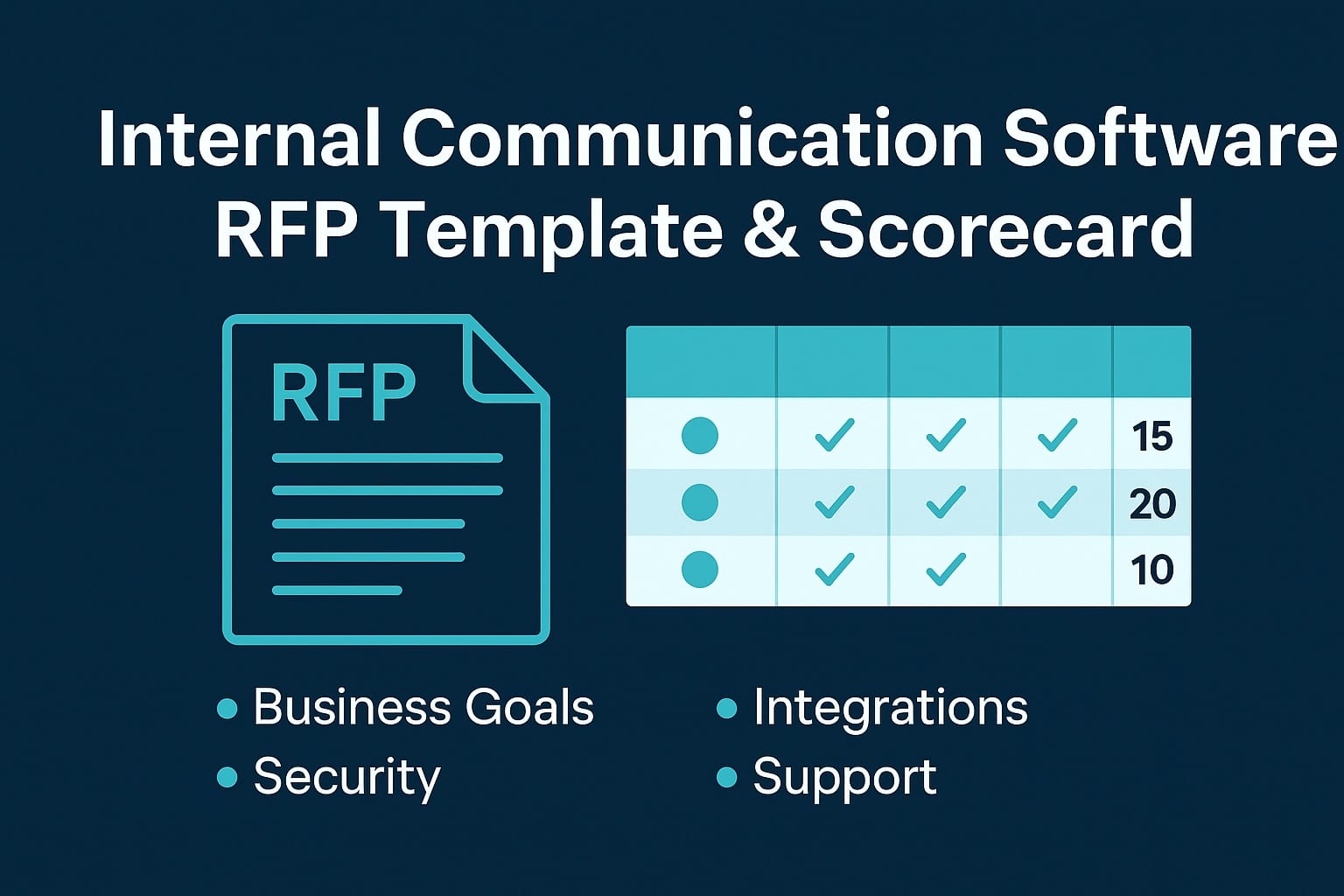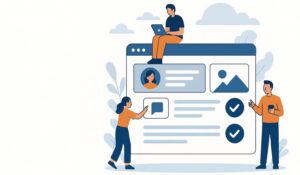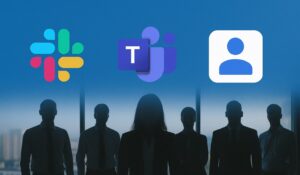Selecting the right internal communication software or employee communication platform is critical – not just for sending timely updates, but for truly connecting your workforce across every channel. When companies use too many tools in silos, they face high costs and lower productivity. For example, miscommunication costs businesses an average of $12,506 per employee each year, which equals $2.5 million annually for a 200-person company. Productivity may also fall by up to 26% (pebb.io). Even worse, 83% of companies have communication silos, and 97% say those silos hurt performance. Altogether, silos cost businesses about $3.1 trillion each year in lost revenue and productivity.
Because of these risks, organizations should use a structured process when evaluating vendors. An internal communication software RFP template or an employee communication platform RFP checklist provides that structure. With it, companies can check important needs such as tool consolidation, integrations, AI automation, gamification, and multi-channel reach.
This guide gives procurement officers, IT leaders, and HR professionals a clear framework. It helps them assess vendors, avoid common mistakes, and choose tools that reduce silos, save money, and boost engagement. As you read, you will also see how HubEngage can stand out as the right choice for many organizations.
Why an Internal Communication Software RFP Matters
Many teams make the mistake of selecting tools based only on price or a single feature. However, an RFP process ensures that you look at the full picture. By setting clear requirements and comparing vendors fairly, you avoid surprises later. In fact, research shows that structured internal comms vendor evaluation improves software adoption rates and reduces buyer regret.
Issuing a thoughtful employee communication platform RFP ensures you:
- Clarify your business goals—what outcomes matter (e.g., engagement, reach, analytics)
- Standardize vendor proposals—enabling fair comparisons and smoother evaluation
- Reduce tool sprawl—by consolidating functions and lowering costs
- Drive stakeholder alignment—bringing procurement, IT, HR, and Comms together early
👉 For more context on evaluating tools, review our Best Internal Communication Tools by Channel cluster page.
Best Practices from Leading Internal Communication Software RFP Templates
Based on analysis of several leading guides and RFP examples, here are best practices to integrate into your own internal communication software RFP template:
1. Provide Clear Context and Background
Always start with a concise background about your organization, industry, and communication challenges. Explain why you are issuing the RFP and what you expect vendors to solve, and outline your current communication environment (tools in use, employee demographics, global footprint).
2. Define Objectives and Scope
Clearly state your communication objectives (e.g., unify channels, improve frontline reach, measure engagement). Describe the scope of the solution – who will use it, across how many sites, and expected outcomes—and list success metrics such as adoption rates, reduced tool count, and improved engagement scores.
👉 For teams with remote and deskless staff, explore our Hybrid & Deskless Team Communication Apps guide.
3. List Comprehensive Requirements
Include detailed functional requirements like multi-channel delivery, AI personalization, gamification, analytics, and mobile-first experience. Capture technical requirements such as APIs, integrations with Teams/Slack/SharePoint, HRIS, LMS, and CRM. Add non-functional requirements (SOC 2, ISO 27001, GDPR, uptime SLAs, scalability) and be transparent about budget expectations to avoid mismatched proposals.
4. Structure the Evaluation and Scoring
Define clear evaluation categories (functionality, integrations, security, support, cost) and use weighted scoring matrices so evaluators can compare vendors objectively. Share evaluation criteria upfront with vendors for transparency.
5. Define Timelines and Milestones
Specify key dates: RFP release, vendor Q&A period, proposal deadline, shortlisting, demos, selection, and go-live. Provide approximate implementation timelines and any phasing expectations.
6. Stakeholder and Governance
It is important to identify who in your organization will review responses—procurement, IT, HR, communications, and senior leadership—and outline how governance will work during implementation (steering committees, project sponsors).
7. Support and Services Expectations
Request clarity on vendor support models: 24/7 availability, dedicated CSM, onboarding, and training. Ask for adoption resources like toolkits, comms templates, and change management guidance.
8. Submission Guidelines
Specify the proposal format, length limits, and required documents. Provide a clear point of contact and instructions for submitting questions.
9. Encourage Innovation
Leave space for vendors to suggest creative approaches, future roadmap alignment, or value-added features beyond the checklist.
By incorporating these best practices, your internal communication software RFP template will:
- Ensure fair comparison of vendors.
- Reduce ambiguity and risk.
- Align internal stakeholders.
- Accelerate the path to choosing a platform that truly meets your communication goals.
Key Sections to Include in an Internal Communication Software RFP Template
Your internal communication software RFP template should include:
1. Project Overview & Business Goals
Provide concise company background, objectives, and expected benefits (e.g., consolidation, engagement uplift, cross‑channel messaging). Include key metrics like desired adoption rates, engagement KPIs, or reduction in redundant tool spend.
2. Scope & Deliverables
Detail expected functionality: multi‑channel capabilities, AI personalization, gamification modules, analytics dashboards, integrations, support levels, rollout phases.
3. Integrations & Technical Requirements
Specify details for email (SMTP), HRIS, payroll, LMS, CRM, Microsoft Teams, Slack, single sign‑on (SSO), API access, and data residency.
👉 For more on integrations and vendor comparisons, see Slack vs Teams vs All-in-One Employee Apps.
4. Security & Compliance
Outline expectations for SOC 2, ISO 27001, GDPR, RBAC, MFA, encryption, audit logs, and data segregation.
👉 When planning crisis readiness, you may also review our Crisis Communication Software resource.
5. Support & Services
Define SLAs, training expectations, CS managers, change management support, and global availability.
6. Evaluation Criteria & Scoring
Use a weighted matrix (1–10 scoring) across categories—weighted by priority.
7. Timeline & Process (Discovery to Rollout)
Include RFP issuance, proposal deadline, evaluation window, demo period, selection date, and implementation kickoff.
8. Submission Instructions
Clarify format, contact points, and any compliance annexes or addenda.
Evaluation Criteria & Scoring for Employee Communication Platform RFPs
Build a customizable scorecard such as:
| CategoryWeight (%)Notes | ||
|---|---|---|
| Multi‑channel reach (push, email, SMS, Teams, Slack, WhatsApp, signage) | 25 | Core to engagement strategy |
| AI & Gamification features | 20 | Drives adoption and behavior |
| Security & Compliance | 20 | Non-negotiable for vendor selection |
| Integrations & API Support | 15 | Must connect with existing systems |
| Support & Training | 10 | Critical for rollout success |
| Cost & Scalability | 10 | Ensure total value, not just sticker price |
📊 Consider platforms like HubEngage, which score highly for multi-channel delivery (from push notifications to text messaging, WhatsApp, Teams, Slack, email, and even digital signage) plus AI-driven personalization and gamification to keep employees engaged.
👉 Explore our Employee Communication Platform product page to see how HubEngage ranks across these categories.
Creating Your RFP Team & Securing Leadership Buy‑In
- Assemble a cross‑functional team
- Procurement: Manages process, contracts, and evaluation
- IT/Security: Evaluates technical feasibility, integration, and compliance
- Employee Communications / Engagement / HR: Defines goals, user adoption strategies, and engagement metrics
- Define roles & responsibilities
Allocate tasks: RFP drafting, stakeholder interviews, scoring coordination, vendor coordination, senior review. - Engage senior leadership
- Present a high-impact business case: quantify silo costs (e.g., $12,500+ per employee)
- Highlight benefits: consolidated tools, improved adoption, operational savings, security risk mitigation
- Use visual aids (matrix, timeline, ROI scenarios) for clarity
- Build consensus early
Run internal briefings, draft reviews, and pilot scoring sessions so the process feels collaborative, not imposed.
👉 For more insights on engaging leadership and frontline teams, check our Frontline Worker Communication Tools.
Importance of AI Automation, Search, Chatbots, and Gamification
Why AI Automation Matters
AI can cut down repetitive work. It helps by:
- Creating newsletters and announcements automatically
- Flagging inappropriate content
- Measuring sentiment in employee feedback
- Delivering analytics in real time
AI search and chatbots improve productivity further. They let employees find HR policies, pay stubs, or training resources instantly. This reduces the load on HR and IT teams.
Why Gamification Matters
Even the best tool will fail without adoption. Gamification encourages use by rewarding actions like reading posts, commenting, completing surveys, or recognizing peers. Employees can earn points, redeem them for rewards, and see how they rank on leaderboards. This friendly competition boosts engagement.
Together, AI and gamification make platforms more than just tools – they turn them into engagement engines.
👉 For a budget-friendly starting point, see our Free Internal Communication Tools article.
Common Mistakes to Avoid in an Internal Communication Software RFP
- Underestimating silos: Tool fragmentation is costly and disengaging—statistically proven.
- Monthly cost over lifecycle value: Cheaper tools may lack adoption support or long-term ROI.
- Late IT involvement: Can result in integration, compliance, or support hurdles.
- Neglecting adoption strategy: Engagement features like AI and gamification are essential, not optional.
Consolidation of Tools: Why It Matters in Employee Communication Platform RFPs
Organizations often juggle numerous overlapping platforms – multiple messaging apps, email bulletins, signage feeds, SMS alerts, and Teams announcements—all with separate admin consoles. This leads to:
- High costs: Licensing, integrations, and maintenance multiply.
- Low engagement: Fragmented messaging confuses employees and loses attention.
Statistics reinforce the cost and impact of siloes:
- Miscommunication costs $12,506 per employee per year, equaling $2.5 million annually for a 200-person company.
- Communication silos affect 83% of companies, and 97% say performance suffers as a result; overall cost to businesses is $3.1 trillion annually.
- In customer operations, 54% of organizations report silo inefficiencies, with a 200-agent contact center losing $1.5 million annually in labor costs.
360-Degree Engagement Through Consolidation
True impact comes when organizations move beyond channel consolidation and bring together communications, social interactions, recognitions, surveys, instant messaging, and AI chatbots into one unified employee experience. This 360-degree engagement model:
- Drives adoption: Employees only need one app instead of five separate ones.
- Simplifies admin oversight: One console to create, publish, and manage campaigns, with consolidated analytics instead of stitching together data in Power BI from multiple systems.
- Improves engagement metrics: Employees participate more consistently when engagement, recognition, and communication happen in the same space.
Multi-Channel Delivery Matters
Even within one platform, a multi-channel approach ensures communication meets employees where they are. Push notifications, SMS, WhatsApp, Teams, Slack, email, and digital signage can all be leveraged to avoid confusion and guarantee message reach.
Future-Proofing With Unified Platforms
Even if your organization only needs surveys or recognition today, selecting a unified solution allows you to easily scale into comms, social, chatbots, or IM later without painful reintegration. This flexibility future-proofs your investment and helps secure executive buy-in.
👉 Learn how HubEngage delivers unified, scalable solutions on the Employee Communication Software product page.
Download the Internal Communication Software RFP Template
Get your free, fully editable internal communication software RFP template and employee communication platform RFP checklist, featuring:
- Business goals and feature sections
- Integration and security checklists
- Sample scoring matrix with dynamic weights
- Timeline and stakeholder roles framework
👉 [Download the Internal Comms RFP Template here]
Final Thoughts
Issuing a well-structured internal communication software RFP template or employee communication platform RFP is more than a procurement step—it is a strategy for better engagement and efficiency. By focusing on consolidation, AI, gamification, and multi-channel reach, you reduce costs, improve adoption, and deliver a complete engagement experience.
HubEngage stands out because it brings comms, surveys, recognition, social, chatbots, instant messaging, and digital signage into one app. For admins, this means one place for analytics and management. For employees, it means easier access and better engagement. With AI and gamification built in, HubEngage is both future-ready and proven to drive ROI.
👉 Ready to see how it works? Visit our Employee Communication Platform product page to request a demo or explore pricing.
👉 To learn more, explore our Internal Communication Tools guide, Employee Communication Platform overview, and Frontline Worker Communication Tools for additional insights.
FAQs
How do you write an internal communication software RFP?
Start with a business case, define requirements clearly, include stakeholder input, and use a structured internal communication software RFP template with scoring criteria.
What should be included in an employee communication platform RFP template?
Add business overview, goals, integrations, security, AI, gamification, support, scoring, and submission guidelines.
How do you evaluate internal comms vendor RFP responses?
Use a weighted scorecard aligned with your priorities—multi-channel reach, security, integrations, AI, support, cost—and compare vendors side by side.
Why is a checklist important when creating an internal communication software RFP?
An RFP checklist ensures no requirement is missed, speeds up evaluation, and simplifies vendor comparison.
Do you have examples of internal comms RFPs?
Yes, many sample RFP examples exist online. Structured templates reduce the risk of missing key areas like integrations, compliance, or adoption.
What are common mistakes in employee communication platform RFPs?
Mistakes include focusing only on cost, ignoring frontline needs, excluding IT/security, and overlooking adoption drivers like AI and gamification.
How can AI chatbots and automation be included in an RFP?
Modern RFPs should ask about AI-driven automation, moderation, sentiment analysis, and chatbots, since they reduce workload and improve productivity.
How do you compare multiple internal communication software vendors fairly?
Create a scoring matrix with weighted criteria (e.g., 25% for multi-channel reach, 20% for AI, 20% for security, etc.) so the evaluation is clear and fair.













